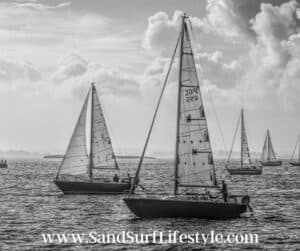Knowing proper terminology before heading out onto the waves can make or break your experience and knowing where your boat stands is no exception. By understanding your boat’s deadrise and knowing how to counteract it out on the water will only make your time more enjoyable and safer for your passengers.
Understanding some terminology is key before defining exactly what the deadrise is.
Since the deadrise is part of the boat’s construction, it’s important to understand the hull and the keel of a boat.
A keel is the weighted, vertical flat blade that runs down along the hull of a boat. While it acts as a ballast, it keeps the boat from tipping, or heeling, in the water due to the wind or extra weight in the boat. Since it is under the waterline, it creates a track and counteracts the sideways force of the wind if you are riding in a sailboat and also helps cut through the water if you are riding in a boat with an engine. A keel is necessary to function as a ballast and your boat is in danger of capsizing without one, unless the boat is double-hulled, like a catamaran.
The hull is the body of the ship—a covered hull usually has a deck, while a dinghy may be open at the top. Depending on how large the boat is, the deck may have a mast for a sail or other structures. Boat hulls have varying types of shapes; when it comes to discussing deadrise, most boats affected by that angle are displacement hulls or planing hulls. Displacement hulls are supported mostly through buoyancy and are heavier than planing hulls. Planing hulls, on the other hand, are built to increase speed and decrease draft, reducing the wetted surface. While planing hulls can be flat bottomed or V-bottomed, the planing hulls referenced in with deadrise are V-bottomed.
Other Terms to Know:
Aft is the rear of the boat.
Draft is the vertical distance that a boat penetrates the water.
 The chine is the line that runs across the boat where the angle shifts. A hard chine is when the angle is barely rounded, while a soft chine is when the angles are rounded but they still meet at distinctively different angles.
The chine is the line that runs across the boat where the angle shifts. A hard chine is when the angle is barely rounded, while a soft chine is when the angles are rounded but they still meet at distinctively different angles.
The chop is any sort of smaller wave, usually isolated, that is caused by wind and makes sailing uncomfortable and hard to steer.
Forward means anything at the front of the boat, typically when the hull starts to angle upward.
Heeling is when the boat tips from one side to the other, typically due to the wind on the sails or extra weight in the boat.
Port is the left side of the boat.
Starboard is the right side of the boat.
A transom is the reinforcement on the stern of the boat that extends above the waterline and is used to support machinery such as an outboard motor, a rudder, or in the case of pleasure boats, a swimming or access platform.
Wetted surface means the amount of water in which the keel and hull is in contact. The larger the wetted surface, the more of the boat sits in the water and the less planing that occurs.
What is the “deadrise?”
The “deadrise” is the rising horizontal line from where the keel connects to the hull to the sideboards of the boat, creating a V shape on the bottom of the hull. Most boats with this design have a V shape that is between 6 to 23 degrees, which is called the “deadrise angle”.
The angle is typically measured at the bottom of the transom all the way to where the keel connects, as on many boats, the deadrise angle varies. Sometimes the deadrise is steeper in the front and becomes lower in the back, depending on what the boat is to be used for.
The boating industry considers a deep-V deadrise to be around 20 to 21 degrees, a modified-V deadrise to be between 16 and 20 degrees, and a shallow-V deadrise to be less than 16 degrees. Flat bottomed boats have what is literally called a flat bottomed deadrise, having a deadrise of under two degrees.
How Long Does It Take to Learn to Sail? Find out here.
What does the deadrise do?
The deadrise is important to the ride your boat takes—the greater the V-shape, the smoother the ride. It also provides more support in rougher waters if you have a boat with a greater deadrise. When the V is deeper and the hull is narrower, the boat will feel more likely to tip.
Some disadvantages to the deep-V hull are a need for more power and less efficiency. Deep-V boats also have a deeper draft.
Why is the angle important?
Understanding what deadrise your boat has is knowing immediately how your boat will perform.
The flatter the shape of the deadrise angle, the easier the boat will plane on the water and will need less horsepower or wind to move. On the other hand, a boat with a deep deadrise, closer to 23 degrees, is used by high-speed planning boats. They need more horsepower to provide lift for the boat but can then give you a smoother ride. While it varies from boat to boat, it is widely considered that the deeper the V, the better.
But how does that angle translate to any type of boat, especially those used for pleasure sailing? The shallower the V-shape, the more stable the boat is at rest, so don’t worry about having a rough go if you’re just planning to gently cruise in your boat. Taking them at higher speeds, though, may cause you some issues in stability.
The angle is also important to a few other factors of sailing, including turning. The larger the deadrise angle, the easier it is for the boat to bank into turns. The larger the angle, the less spray is thrown, as well.
 Measuring Deadrise:
Measuring Deadrise:
Because boats vary, and many have differing hull sizes or shapes, the deadrise is typically measured at the transom so it can be compared to other boats. Measuring it from the front when a boat designer has created a pointed bow is incorrect and will not give you the proper deadrise measurement. This is also an issue if the chine is not consistent throughout the construction of the boat. When this happens, the deadrise varies throughout the boat and could be categorized as a variable deadrise hull.
As mentioned before, some boats also have multiple deadrise measurements and can vary depending on the make or model. If looking to purchase or rent a boat, check the specifications of the boat—many manufacturers only list one deadrise measurement. While measuring from the transom is the typical deadrise measurement in the industry, it is not standard or required and may vary. Often, a manufacturer will only provide the steepest deadrise measurement, which is typically at the bow and not at the transom, making the number misleading.
If you want the most accurate information possible about your boat, look for the deadrise measurement at the transom, the forward, and the bow to give you the most accurate depiction of the deadrise of your boat.
Considering what is the “best deadrise” is extremely variable and based on what you intend to use your boat for. While many sit within the 24-degree range, most boats vary in size depending on use and location—lakes or open ocean. Searching for something that works for you will be best.
When it comes down to deadrise and what angle is best for you, consider what you will be doing in your boat. If you find yourself wanting to power around in your speedboat, consider a deeper V deadrise. If you intend on sitting in the water and fishing, a shallower deadrise will make your experience much more comfortable and enjoyable.
Please note: This blog post is for educational purposes only and does not constitute legal or medical advice. Please consult a legal expert or medical professional to address your specific needs.



 Measuring Deadrise:
Measuring Deadrise: